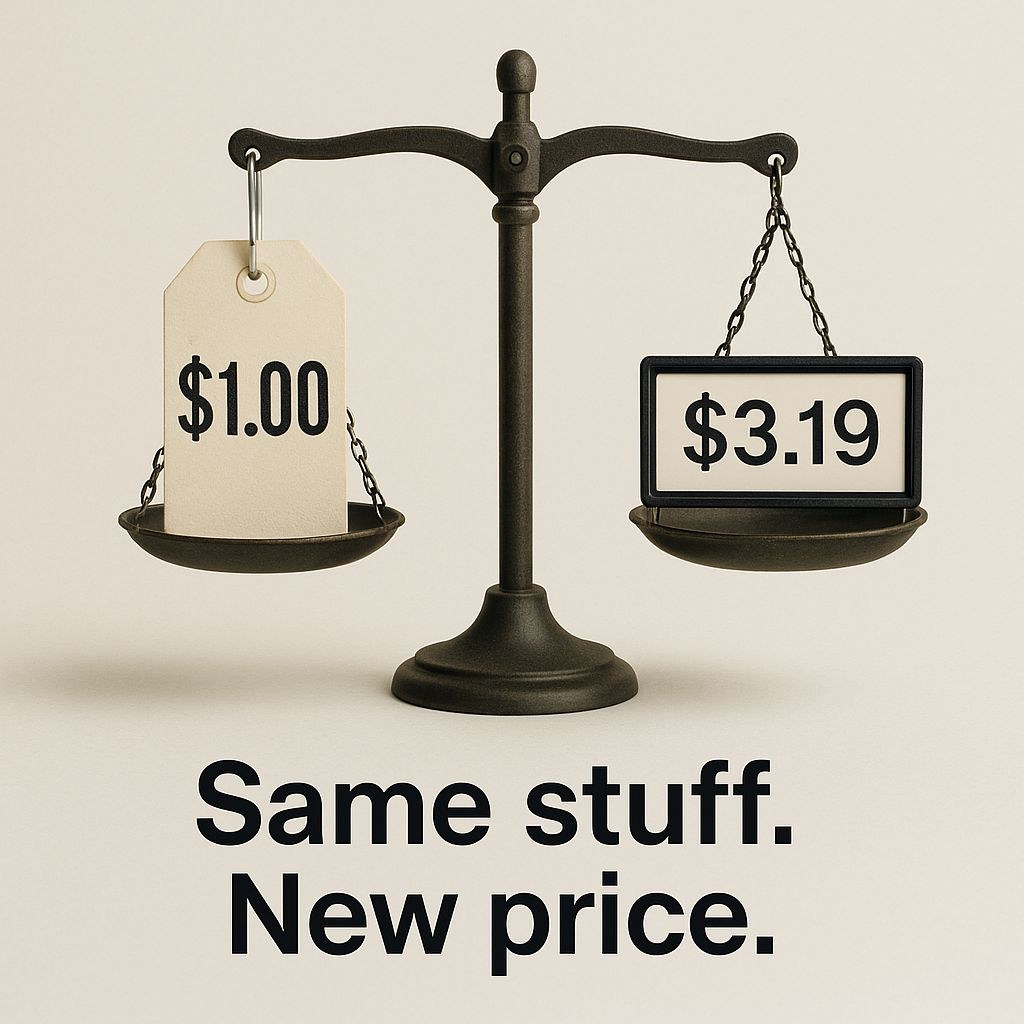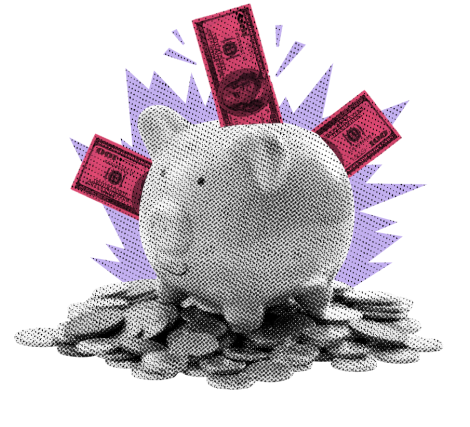
Flashback to 2019: Markets were hopeful, rates were low, eggs were cheap.
KEY TAKEAWAYS
- CPI has increased nearly 25% since 2019, locking in higher prices permanently.
- Inflation coming down doesn't mean prices are going down—just rising slower.
- The current CPI level (319) means prices have more than tripled since base year 1983.
- Tariffs create lasting price hikes, not just short-term inflation blips.
- Stock markets may be bullish, but real-world affordability is still strained.
MY HOT TAKES
- The market’s pending bullish rebound ignores the lingering pain of high consumer prices.
- Tariff-driven inflation is “transitory”—but price hikes are permanent.
- The Fed may be done hiking, but the damage is already in the price level.
- We don’t need lower inflation—we need lower prices.
- You can quote me: “Congrats, the market will go up like a rocket ship. Too bad your grocery bill’s flying coach.”
Upgraded. Have you heard? The US stock market just got an upgrade to strong buy, or rather, “rocket ship” buy, which, I think is probably the equivalent to turning it up to 11. Ponder that for a minute and let your mind wander back to September of 2019.
There is a trade war between the US and China, which is showing no signs of letting up, but a last-minute delay of a tariff increase gave markets hope. House Democrats announce a formal impeachment inquiry into the President. WeWork, a Wall Street darling for 15 minutes, watched its glory fade with the collapse of its IPO–it wouldn’t end well. Just about every state in the US joined up to launch an antitrust investigation into Google, over its dominance in digital advertising. Global economies are faltering. The ECB cut its deposit rate to -0.5%. No, that minus sign is not a typo, it is NIRP, negative interest rate policy. The US economy is showing signs of exhaustion leading the Fed to start cutting interest rates. September would see rates come down an additional 25 basis points. The stock market is doing alright, up some 21% for the year after a difficult end to 2018. The Fed cuts were instrumental in breaking equities out of sideways chop that began in the early spring. 10-year Treasury Notes are yielding a comfy 1.7% and mortgage rates are 3.75%. Eggs cost $1.30 / dozen, and inflation is around 1.7%. Inflation has come down from a brief spike to a trade-war-inspired 2.7% a year earlier.
Looking back, things felt a bit turbulent in the world, but markets seemed to be taking everything in stride. A bullish haze had fallen over the stock market and it felt… well, it felt pretty good. Now you know what happened next. Who could have imagined it? We don’t need to go over the pandemic, more impeachment hearings, inflation, bank failures, wars, lots of death, massive inflation, aggressive Fed rate hikes, overuse of the word “unprecedented”... market mayhem would be redefined… several times since 2019.
So, here we are, wiser, travel-worn, and in need of respite. We had a few good years in the stock market which culminated in the election of a new president that was pro-business, which can be translated into “pro-market.” Stocks rejoiced, of course. Inflation was coming down and the Fed had hung its musket back up over the mantle, metamorphosed from hawk to dove. It was the dawn of a new era. AI was born in the aftermath of a tough rate-hiking regime and promised economic growth rarely seen. It was fitting–deserved after the markets fought their way through the pandemic, inflation, and rate hikes. We survived unprecedented inflation, which was put down by unprecedented rate hikes. A well-deserved, relaxing summer awaits us. 🫤
If you are anything like me, you are still bothered by how much things cost these days. I try to push that emotion down considering the upside that should be ahead, but it keeps creeping up, spoiling my happy moments. The problem is that prices don’t go down, so we are kind of stuck here. “But inflation is down, Mark,” you assert, “so calm down.” Sure, inflation is lower than it was in the past few years, but inflation measures the rate of change of prices. So, even if inflation goes to 0%, prices aren’t going down. Let’s do a quick exercise. Have a look at the following chart then follow me to the close.

This is a chart of the actual Consumer Price Index. People often misquote the CPI in percent change. If you ask many people, they would say that CPI is 2.4%, coming down and just slightly above the Fed’s 2% target. Actually, 2.4% is the year over year percent change of the Consumer Price Index pictured above. The index measures a weighted basket of consumer goods prices and puts them in an index with a base year of 1983 (it’s actually an average between 1982-1984). In the base year the index is set to 100. Right now, the index is at 319! A good way to interpret that is by thinking that something that cost $100 when “Every Breath You Take” by The Police was on the top of the charts, will now cost you $319. How about something that cost $1 in 1983 costing almost $3.20 today. That doesn’t seem as daunting, but it’s still kind of crazy, isn’t it?
The chart above shows us the window between 2019 and today. You will see by the notation that the CPI has risen by nearly 25% since those “halcyon” days of September 2019. Egg prices today are $6.23, mortgage rates are $6.83, ground beef is $5.79 / pound, and an average car price is $48,000, up from $38,000 in 2019. These are prices that we actually have to pay… in dollars, not percentages!
I will finish with this. As we navigate through this latest round of tariffing and trade spats, it is important to remember something. When politicians, and even some economists tell you that these tariffs will cause a “temporary” blip in inflation, “transient,” you now know better. If tariffs go from 0% to 10%, for example, inflation will jump by 10% for one year, at which time it may settle back to its steady state. That is just math. But you know that the actual CPI will be at 350, and it will stay there even if inflation goes to 0%. “Flashdance…What a Feeling,” by Irene Cara also topped the charts in CPI base year 1983. A 45 RPM of that would have cost you $0.99 at Sam Goody. Today, you will pay about $1.29.
YESTERDAY’S MARKETS
Stocks gained yesterday, getting a boost from President Trump’s announcing a trade agreement with the United Kingdom. The President told us to buy stocks now, it was just a suggestion, not an executive order–hopefully it lasts. 10-year Treasury Note yields added 10 basis points.

NEXT UP
- No economic data today, but next week will be chock full. More earnings releases in addition to more housing data, Consumer Price Index / CPI, Producer Price Index / PPI, Retail Sales, and University of Michigan Sentiment. Check back in on Monday to get your calendars and become the envy of your investment club.
- Fed speaker parade today: Barr, Kugler, Williams, Barkin, Goolsbee, Waller, Musalem, Hammack, and Cook. A lot of talk after Wednesday’s inaction, but you should listen, nonetheless.
.png)

